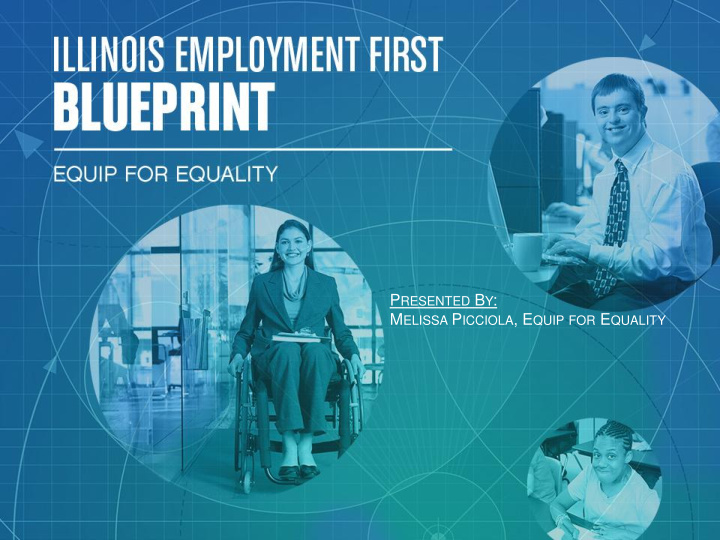



P RESENTED B Y : M ELISSA P ICCIOLA , E QUIP FOR E QUALITY 1
Where We Stand • Historically, people with disabilities in Illinois have received services in segregated settings • Recent efforts to increase community-based services have not extended to employment • 25 years after the Americans with Disabilities Act was passed, nationwide only 20% of people with disabilities are employed • In Illinois, only 6% of people with developmental disabilities are employed in integrated settings
Employment First in Illinois • In 2013, consistent with a national trend, Illinois became an “Employment First” state • Executive Order issued by Governor Quinn requires the state to develop a five-year plan to implement Employment First • Employment First means: “Employment in the general workforce is the first and preferred outcome in the provision of publicly funded services for all working age people with disabilities, regardless of the level of their disability.”
Executive Order Implementation • Executive Order requires 12 state agencies to work with Governor’s Task Force to develop preliminary plan by December 31, 2014 and final plan by June 30, 2015. • Employment First Liaison has not been hired • Preliminary Plan contains activities to be undertaken in order to develop the strategic plan • Workgroups formed to implement activities • Providers, Transition, Marketplace/Employers, Workforce Development-Disability Specific, Data Collection and Sharing
New Administration = New Challenges • Many of the people working on implementing Employment First were not retained by Governor Rauner’s administration • Including many of the state agency representatives serving on the Task Force and on the work groups to develop the Final Strategic Plan • Several Federal grants for employment initiatives are ongoing
Disability Employment Initiative • Funded by U.S. Department of Labor Office of Disability Employment Policy • Given to Illinois Department of Commerce and Economic Opportunity • Goal is to improve employment outcomes for youth and adults with disabilities by increasing participation in existing career pathway systems and programs that build on partnerships among local educational institutions, businesses and disability advocates.
Other Federal Grants • Balancing Incentive Program • Incentives transformation of long-term care system by shifting to community-based services • Employment First initiative funded to help increase access to employment services • SAMHSA Grant to Division of Mental Health • Help to develop infrastructure to expand Individualized Placement & Support model for people with mental illness
WIOA Provisions • The new Workforce Innovations and Opportunities Act has several provisions relating to people with disabilities • Authorizes general workforce development funds and other economic development programs, such as One Stop Career Centers, to focus on people with disabilities. • Requires annual assessments of the physical and programmatic accessibility of One Stop Career Centers for people with disabilities.
Illinois Employment First Blueprint • Intended to provide Illinois policymakers and stakeholders with Recommendations and concrete action steps to increase the competitive, integrated employment of people with disabilities
Illinois Employment First Blueprint • Recommendations focus on 6 areas: • Current Employment Services • Supported Employment Funding & Rates • Engagement of Employers & Workforce Development • Use of Segregated Settings • Transition Services – for youth graduating high school • Data Collection
Employer Engagement & Workforce Development • Employers must support the idea that hiring people with disabilities will help their business • Evidence of the value of hiring people with disabilities and the low cost of providing reasonable accommodations exists • The message still may not resonate for many employers – Public Awareness Campaign: “Think Beyond the Label” – Business Leadership Networks
Section 503 regulations • Prohibits federal contractors and subcontractors from discriminating against people with disabilities, requiring them to take affirmative action to recruit, hire, promote and retain people with disabilities. • Strengthens the affirmative action requirements of the regulations to assist contractors in their efforts to recruit and hire people with disabilities and improve job opportunities for them. • Contractors with a written affirmative action program already in place as of the effective date are granted additional time to comply with the new affirmative action program provisions.
Section 503 Regulations • Establishes a nationwide seven percent utilization goal for qualified people with disabilities to be applied to each of the contractor’s workgroups or the entire workforce if the contractor has 100 or fewer employees; • Requires contractors to annually document and update several quantitative comparisons for the number of people with disabilities who apply for jobs and the number hired; • Requires that contractors invite applicants to self-identify as persons with a disability at both the pre-offer and post-offer phases of the application process and renew that invitation every five years;
Employer Engagement & Workforce Development • Existing workforce development programs are not widely used by people with disabilities • One Stop Career Centers – Disability Program navigators established in One Stops to inform people with disabilities about the work support programs available. – Studies show that through 2008, the use of Illinois One Stop Career Centers and its services by people with disabilities is consistent with the national average of approximately three percent.
Employer Engagement & Workforce Development • Disabilityworks – Housed within DCEO – Cooperative between the Chicagoland Chamber of Commerce, businesses, state and local governments and community service providers to support employers looking to hire individuals with disabilities. – Engages directly with employers to meet labor market demands through employer education and job matching. – Through information and referral, people with disabilities can find job training or job placement programs.
Recommendations for Employer Engagement and Workforce Development • Encourage creation of and membership in regional Business Leadership Networks throughout Illinois • The Division of Rehabilitation Services, Department of Commerce and Economic Opportunity and Department of Employment Security should work together on outreach to employers and the disability community • Section 503 regulations, reasonable accommodations and customized employment • Awareness of workforce development initiatives
For More Information • Visit Equip for Equality’s website • www.equipforequality.org/employmentfirst • Melissa Picciola – melissa@equipforequality.org – (312) 895-7328
Recommend
More recommend